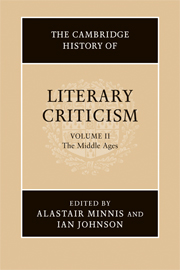Book contents
- Frontmatter
- Introduction
- I THE LIBERAL ARTS AND THE ARTS OF LATIN TEXTUALITY
- II THE STUDY OF CLASSICAL AUTHORS
- III TEXTUAL PSYCHOLOGIES: IMAGINATION, MEMORY, PLEASURE
- IV VERNACULAR CRITICAL TRADITIONS: THE EARLY MIDDLE AGES
- 9 Medieval Irish literary theory and criticism
- 10 Anglo-Saxon textual attitudes
- 11 Literary theory and practice in early-medieval Germany
- 12 Literary criticism in Welsh before c. 1300
- 13 Criticism and literary theory in Old Norse-Icelandic
- V VERNACULAR CRITICAL TRADITIONS: THE LATE MIDDLE AGES
- VI LATIN AND VERNACULAR IN ITALIAN LITERARY THEORY
- VII BYZANTINE LITERARY THEORY AND CRITICISM
- Bibliography
- Index
- References
11 - Literary theory and practice in early-medieval Germany
from IV - VERNACULAR CRITICAL TRADITIONS: THE EARLY MIDDLE AGES
Published online by Cambridge University Press: 28 March 2008
- Frontmatter
- Introduction
- I THE LIBERAL ARTS AND THE ARTS OF LATIN TEXTUALITY
- II THE STUDY OF CLASSICAL AUTHORS
- III TEXTUAL PSYCHOLOGIES: IMAGINATION, MEMORY, PLEASURE
- IV VERNACULAR CRITICAL TRADITIONS: THE EARLY MIDDLE AGES
- 9 Medieval Irish literary theory and criticism
- 10 Anglo-Saxon textual attitudes
- 11 Literary theory and practice in early-medieval Germany
- 12 Literary criticism in Welsh before c. 1300
- 13 Criticism and literary theory in Old Norse-Icelandic
- V VERNACULAR CRITICAL TRADITIONS: THE LATE MIDDLE AGES
- VI LATIN AND VERNACULAR IN ITALIAN LITERARY THEORY
- VII BYZANTINE LITERARY THEORY AND CRITICISM
- Bibliography
- Index
- References
Summary
Written transmission of German texts begins in the Old High German (= OHG) period. The earliest texts of significance date from the last third of the eighth century, but the richest period of transmission is the ninth century. Though the OHG period witnesses the dawn of writing in German it was already a period of massive cultural transition. This was the time of the spread and consolidation of Christianity among the German tribes; consequently a few texts preserve tantalising traces of pagan thought. Virtually all the texts which survive do so thanks to the church. The church relied on Latin writing, while secular culture was orally transmitted in the vernacular. Some texts reflect the struggle to express the Latin culture of the church in German writing; others the attempt to record secular vernacular culture. And within the particular sphere of vernacular poetry we witness the giant leap from alliterative verse to rhyme.
The surviving OHG texts form a varied if not particularly extensive corpus. Doubtless many more texts were written than have come down to us, but the total written output of the period represents but the tip of the iceberg of the whole of OHG literary culture. That any secular literature has survived at all is remarkable given the church's monopoly of writing. As Alcuin declared in 797, there was not room for both: ‘The Word of God should be read while the clergy are eating. They should listen to the reader, not to the harpist, to the sermons of the Fathers, not to the songs of the pagans.
- Type
- Chapter
- Information
- The Cambridge History of Literary Criticism , pp. 324 - 332Publisher: Cambridge University PressPrint publication year: 2005



